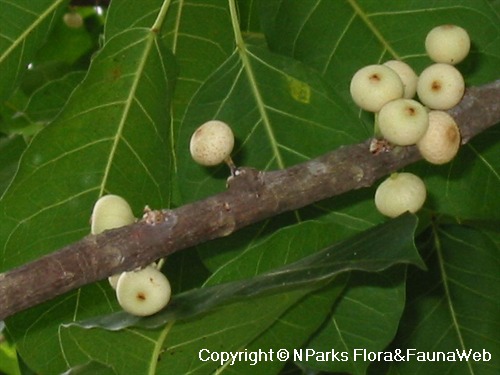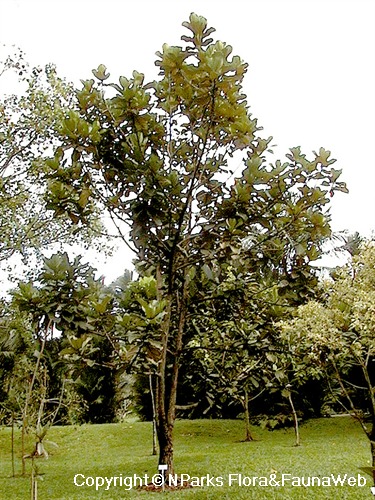
Back
Ficus microcarpa L.f.
| Family Name: | Moraceae |
| Synonyms: | Ficus rubra, Ficus littoralis, Ficus aggregata |
| Common Name: | Malayan Banyan, Jejawi, Curtain Fig, Chinese Banyan, Glossy-leaf Fig, Jawi Jawi, Small-Fruited Fig, Indian Laurel Fig, Laurel Fig, 榕树, 马来亚榕 |
Name
Classifications and Characteristics
| Plant Division | Angiosperms (Flowering Seed Plants) (Dicotyledon) |
|---|---|
| Plant Growth Form | Tree (Medium (16m-30m)) |
| Lifespan (in Singapore) | Perennial |
| Mode of Nutrition | Autotrophic |
| Plant Shape | Rounded, Umbrella, Broad / Mushroom / Hemispherical |
| Maximum Height | 30 m |
Biogeography
| Native Distribution | India, South China, Indochina, Malesia, Polynesia, Tropical Australia |
|---|---|
| Native Habitat | Terrestrial (Primary Rainforest, Secondary Rainforest, Monsoon Forest, Coastal Forest, Freshwater Swamp Forest, Riverine, Disturbed Area / Open Ground) |
| Preferred Climate Zone | Tropical |
| Local Conservation Status | Native to Singapore (Least Concern (LC)) |
Description and Ethnobotany
| Growth Form | It is a latex-containing, evergreen tree up to 30 m tall, with a rounded or flattened crown shape and numerous, slender aerial roots hanging down from the branches, and twigs. These roots eventually develop into stout, pillar roots. It is one type of strangler fig and may begin life as an epiphyte. This species resembles Ficus benjamina, but its twigs do not droop and the leaf tip is usually more blunt. |
|---|---|
| Crown | Rounded or flattened. |
| Trunk | Bark is light grey and smooth. Branches are held horizontally or inclined. They have an abundance of aerial roots hanging down from them that form a curtain-like mass. Some of these roots develop into woody, pillar roots that help support the spreading tree crown. |
| Roots | Numerous, slender aerial roots hanging down from the branches, and twigs. These roots eventually develop into stout, pillar roots |
| Foliage | Its alternate, stalked leaves have leathery leaf blades that are oval, elliptic to slightly reverse egg-shaped. They also have blunt, or scarcely pointed tips, and are 2–14 by 1–9 cm. |
| Flowers | The plant is monoecious, producing unisexual flowers on the same individual. Both male and female flowers are stalkless. |
| Fruit | Its round syconia (figs) develop singly, or in stalkless pairs, and are 5–7 mm wide. They ripen a dark pink to deep purple at maturity. |
| Habitat | Habitat: Native to moist climates at altitudes of less than 1830 m. Occurs on rocky coasts, cliffs and riverbanks. It is also found in mixed forests, mountain forests, back mangroves and swampy flood plains inland of mangroves. In Hawaii, it is considered an invasive species. |
| Associated Fauna | It is the locally preferred food plant for caterpillars of the butterfly, the scarce silverstreak (Iraota rochana boswelliana), the adult of which lays its eggs singly on the stem or the undersides of leaves. The ripe figs are eaten by frugivores, such as birds, bats, rodents, squirrels and long-tailed macaques. |
| Cultivation | It can be propagated by seed, stem cutting or air-layering. |
| Etymology | Latin Ficus, commercial edible figs; Latin micro, small; Latin karpos, fruit, referring to the plant’s small figs |
| Ethnobotanical Uses | Medicinal: Headache,
toothache, and wounds can be treated by the administration of the bark, latex
from the leaves, and roots. Additionally, colic and liver problems can be
treated by ingesting the bark, and latex from the leaves. Others: The aerial roots of this species are used in Chinese traditional medicine to treat toothache, rheumatism and inflammation of the feet. In India, latex extracted from the leaves is consumed to treat liver disease or applied to the skin to treat colic. They use the bark and leaves to relieve headaches, while leaves and roots are thought to promote healing of bruises and wounds. Some Buddhists consider this species to be sacred. They make offerings to the trees on small altars placed at their base. |
Landscaping Features
| Landscaping | Varieties of this plant species, particularly the golden-green variety, is trained as hedges, roadside border plants, or used in bonsai. It is suitable for planting in large gardens or parks as a shade tree. |
|---|---|
| Desirable Plant Features | Ornamental Fruits |
| Landscape Uses | General, Parks & Gardens, Coastal, Hedge / Screening, Topiary, Suitable for Bonsai |
Fauna, Pollination and Dispersal
| Fauna Pollination Dispersal Associated Fauna | Bird-Attracting (Fruits), Butterfly Host Plant, Bat Food (Fruits) |
|---|---|
| Pollination Method(s) | Biotic (Fauna) (Insects (Ant, Beetle, Fly, Thrip, Wasp)) |
| Seed or Spore Dispersal | Biotic (Fauna) (Vertebrates (Bat), Vertebrates (Other Mammal)) |
Plant Care and Propagation
| Light Preference | Full Sun, Semi-Shade |
|---|---|
| Water Preference | Moderate Water |
| Plant Growth Rate | Moderate |
| Rootzone Tolerance | Moist Soils, Well-Drained Soils |
| Propagation Method | Seed, Stem Cutting |
Foliar
| Foliage Retention | Evergreen |
|---|---|
| Mature Foliage Colour(s) | Green |
| Mature Foliage Texture(s) | Leathery |
| Foliar Type | Simple / Unifoliate |
| Foliar Arrangement Along Stem | Alternate |
| Foliar Attachment to Stem | Petiolate |
| Foliar Shape(s) | Non-Palm Foliage (Obovate, Elliptical) |
| Foliar Venation | Pinnate / Net |
| Foliar Margin | Entire |
| Foliar Apex - Tip | Acute |
| Leaf Area Index (LAI) for Green Plot Ratio | 3.0 (Tree - Intermediate Canopy) |
Floral (Angiosperm)
| Flower & Plant Sexuality | Unisexual Flowers , Monoecious |
| Flower Grouping | Cluster / Inflorescence |
|---|
| Flower Location | Axillary |
| Inflorescence Type | Syconium |
Fruit, Seed and Spore
| Mature Fruit Colour(s) | Pink, Purple |
|---|---|
| Fruit Classification | Multiple Fruit |
| Fruit Type | Fleshy Fruit , Accessory / False Fruit (Pseudocarp) |
Image Repository
Others
| Master ID | 1619 |
|---|---|
| Species ID | 2912 |
| Flora Disclaimer | The information in this website has been compiled from reliable sources, such as reference works on medicinal plants. It is not a substitute for medical advice or treatment and NParks does not purport to provide any medical advice. Readers should always consult his/her physician before using or consuming a plant for medicinal purposes. |










